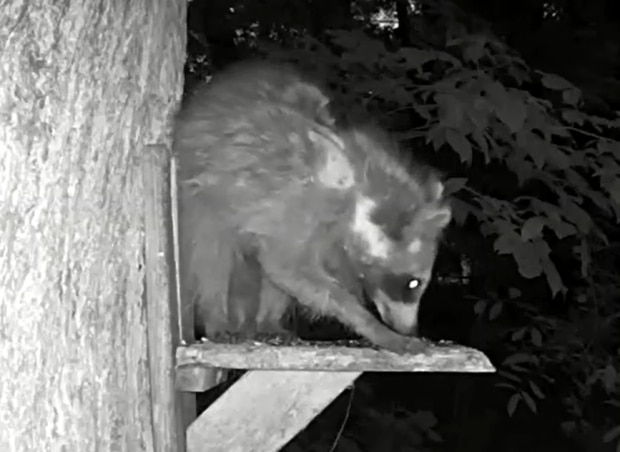Mange is a contagious skin disease caused by microscopic mites that affects mammals. There are different species of mites that can cause mange. The most common type is sarcoptic mange. Sarcoptic mange can often be found in foxes, coyotes, black bears, squirrels, and raccoons. There is also demodectic mange, which affects white-tailed deer. Although it can be difficult to see an animal with mange, disease is a natural part of being a wild animal. If the animal is healthy, their immune system may be able to fight it off and fully recover on its own.
Signs of mange in wildlife
- Moderate to severe hair loss or thinning
- Scabbing
- Thickened or dry, flaky skin
- Underweight
While these are common signs of mange, there are other diseases that can cause similar symptoms. A definitive diagnosis can only be made by viewing a skin scrape sample under a microscope.
Transmission
Mange is spread through direct physical contact with an infected animal or heavily contaminated environments like dens or burrows.
To protect your pets, ensure they are up to date on vaccines. Dogs should receive regular flea, tick, mite, and heartworm prevention. If your pet has direct contact with an animal that has signs of mange, contact your veterinarian. While it’s unlikely, humans can become infected with a very specific variety of mange that causes scabies. If you have direct contact with an animal that has signs of mange, contact your doctor.
What to do if you see an animal with mange
Since mange is transmitted through direct contact, it’s essential to remove or secure all human-associated food sources that encourage animals to gather in the same area. This includes:
- Bird feeders
- Unsecured trash
- Outdoor pet food and food for strays
- Open compost
Mange tends to pop up when wildlife exists in high densities and where intentional feeding takes place. Removing these food sources will help prevent further spread of the disease. You can also help prevent the spread of mange by eliminating or blocking off any den sites on your property, like crawl spaces and under decks and sheds, that may have been used by infected animals.
Other factors can influence an animal’s susceptibility to disease. Rodenticides, especially second-generation anticoagulant rodenticides (SGARs), that are used for rodent control can cause secondary poisoning that can compromise the immune system of carnivores, making them more vulnerable to contracting diseases like mange. Visit this webpage to learn more about wildlife and rodenticide.
Managing for healthy wildlife populations
The Division of Fisheries and Wildlife has the responsibility to manage for healthy wildlife populations. We must balance any potential treatment of an individual animal with the consequences on the population and wildlife community as a whole.
It’s not safe or legal for anyone to attempt to medicate free ranging wildlife. Treatment for mange requires a dosage that is specific to the weight of the individual. The wrong dosage could harm or even kill the animal. The medication used to treat mange can be poisonous to some breeds of dogs, can kill birds, amphibians, fish, and invertebrates, and its effect on many other species is unknown.
Trapping an animal with mange to provide treatment is not a viable option. It is illegal for any wildlife rehabilitator, animal control officer, or any other member of the general public to trap or attempt to trap a wild animal for any reason without the express permission from the Division of Fisheries and Wildlife. Even so, with Massachusetts’ trapping restrictions, only box traps can be used. Coyotes and foxes are very reluctant to enter a box trap. Successful trapping would require extensive baiting, creating wildlife feeding sites, attracting both sick and healthy animals. Since mange is spread through direct physical contact, drawing animals to a baited area could have the unintended consequence of further spreading mange in the population. Additionally, feeding wildlife can result in the habituation of animals. This could cause a localized increase in human-wildlife conflict.
